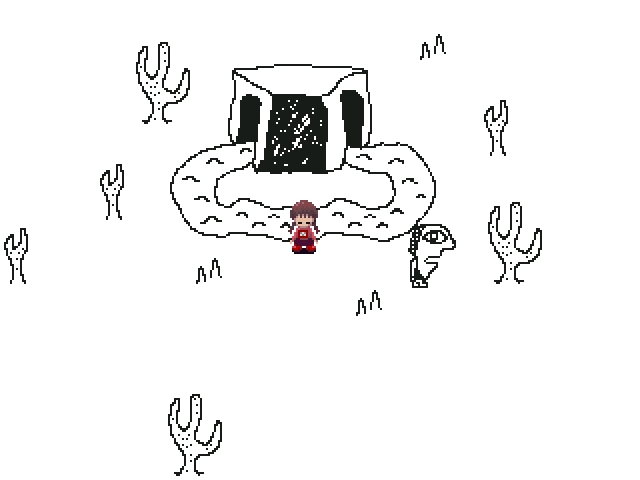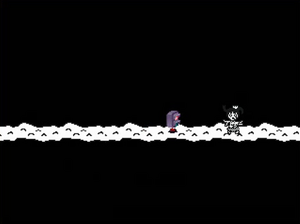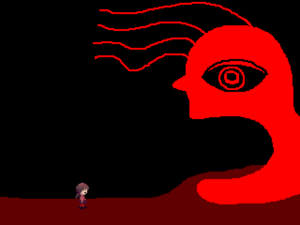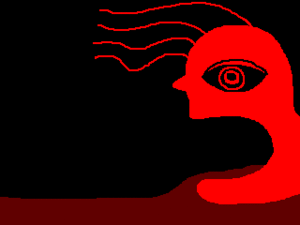White Desert(Akanistha)
色究竟天(しきくきょうてん、Skt:Akanistha、音訳:阿迦尼咤天(あかにたてん)等他)は、仏教の世界観の1つであり、三界のうち、色界及び天上界における最高の天のこと。
色究竟天(Shi Kiku Kyo Ten、Skt:Akanistha、Transliteration:阿迦尼咤天(A Ka Ni Ta Ten)等他) is
The heavens of the top, it is a part of Buddhism view of the world, and 色界 (Form Realm) among 三界(Trailokya)
三界は上から無色界・色界・欲界の3つの世界があるが、色究竟天はその中の色界の最上位に位置する。
色究竟天(Akanistha) is located in the top of 色界(Form Realm) in it although 三界(Trailokya) has the three worlds of 無色界(Formless Realm)・色界(Form Realm)・欲界(Desire Realm) from a top.
「色」とは形体・物質のことで、色界は欲望から離れて清らかな物質や肉体が存在する世界であるが、この天より上は肉体や物質が存在しない無色界になり、形体を有する天処の究る場所であるから、色究竟天と呼ばれる。
Although "色(Color)" is a form and a substance and it is the world where 色界(Form Realm) separates from a desire and a clean substance and flesh exist, a heavens of the top becomes 無色界(Formless Realm) free of greed or matter where neither flesh nor a substance exists, and since it is a place which has described the heavens which have a form, it is called 色究竟天(Akanistha).
※White Desert is 無色界(Formless Realm),Because Monoko, Monoe, Dave is all shadowless(Formless?)
https://www.youtube.com/watch?v=MBZulTanQ98
漢訳の『法華経』序品で阿迦尼咤天=色究竟天と訳されている。
阿迦尼咤天(A Ka Ni Ta Ten) = 色究竟天(Akanistha) in Translation into Chinese 『法華経』 first book
サンスクリット語原典を日本語に訳す(漢文も同じ)と、「下はアヴィーチ(無間)地獄から、上はアカニシュタに至るまで」となる。
the Sanskrit original text -- Japanese -- translating (Chinese writing is also the same)
「下はアヴィーチ(無間)地獄から、上はアカニシュタに至るまで」
"Until the bottom reaches 無間地獄(Hell) and a top reaches 色究竟天(Akanistha) "
※無間地獄(Hell) is Hell in Yumenikki, 色究竟天(Akanistha) is White Desert(Formless Realm)?
Monoko(Statues (game))
Red light/Green light (sometimes abbreviated as RLGL) is a variation of statues. The "it" person stands at one end of the playing field, with the rest of the players at the other end. "It" turns their back to the others and calls out "Green light!" The players then run as fast as they can towards "it". At any time, "it" can face the players, calling out "Red light", and the others must freeze in place. If anyone fails to stop, they are out or must return to the starting line.
Dave Spector(Manhunt)
3 Variants 3.10 Team tag 3.10.2 Manhunt
Main article: Manhunt (urban game)
Manhunt is a mixture of hide and seek and tag, often played during the day. One person is it, while the other players have to hide. Then, the person who is it tries to find and tag them. The game is over when all players are out. Manhunt is sometimes played with teams. In one variant there is a home base in which a player is safe. That version ends when all players who are not safe are out.
Big Red(Red Rover)
Red rover (also known as forcing the city gates and octopus tag) is an outdoor game played primarily by children on playgrounds. This 19th-century children's group game (requiring around 10 or more players total)[1] is thought to have originated in Britain and then spread to Australia, Canada and the United States.
Røver is a Norwegian word for "pirate", so perhaps the early British were showing bravery by daring the Viking raiders to "come over". The 1829 book titled The Red Rover: A Tale by James Fenimore Cooper describes the exploits of a pirate called "Red Rover".[2]
Big Red(Hana Ichi Monme)
Hana Ichi Monme (花一匁?) is a traditional Japanese children's game. The game is similar to the game Red Rover in the Western world. This game is often played in kindergartens and elementary schools.
Lyrics:
(1) Katte ureshii hana ichi monme
(2) Makete kuyashii hana ichi monme
(1) Ano ko ga hoshii
(2) Ano ko ja wakaran
(1) Sōdan shiyō
(2)Sō shiyō
Translation:
We're so happy we won, hana ichi monme
We're so upset we lost, hana ichi monme
We want that kid
We don't understand which kid you mean
Let's talk about it
Yes, let's
The children then huddle to choose a person from the opposing team and return back in line to call out...
※It seems that there is an opinion of having sung signs that he was bought for a human-trafficking contractor.
勝って:買って(won:buy)嬉しい花一匁
(子供が安く買えた。嬉しいねぇ)
He buys:wins it and it is delightful Flower;Child 1 匁;about 3.75g
(The child was able to buy it at a low price.I am glad.)
負けて:まけて(lost:price down)悔しい花一匁
(わが子が値切られてしまって悔しい)
It pricedown:loses and is mortifying Flower;Child 1 匁;about 3.75g
(I am mortifying to bargain for my child)
A continuation of a song is also the same theory...




